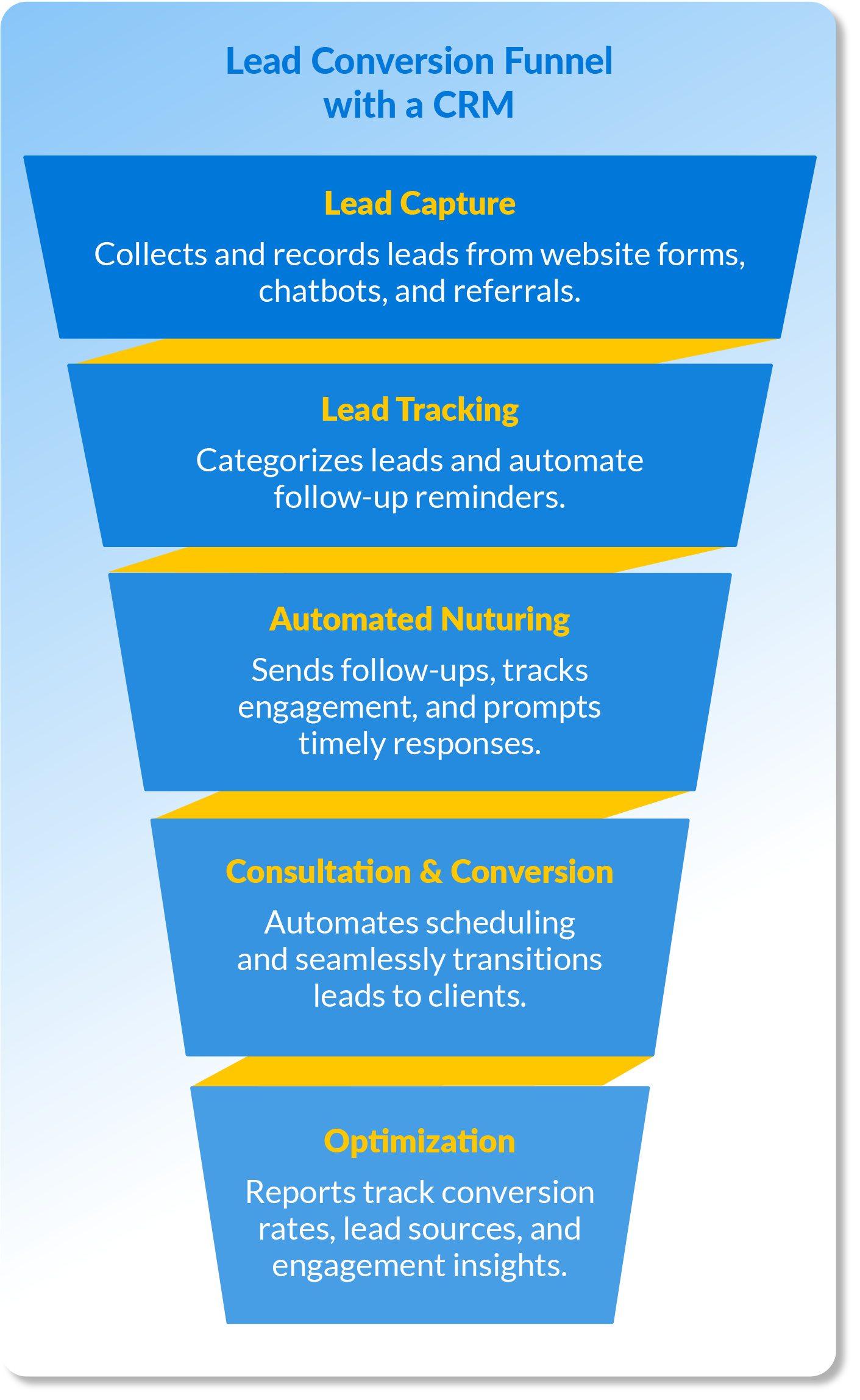Strong client relationships are the foundation of a successful law firm. However, many firms still rely on manual processes to manage these relationships—leading to inefficiencies, missed opportunities, and scattered data. Without a streamlined system, important follow-ups can slip through the cracks, and valuable insights into client interactions can be lost.
Ultimately, client relationships suffer from these poor processes, leading to lower retention rates. For a competitive field like legal and time sensitive practice area such as immigration law, having good client retention is crucial.
The right technology can remedy these issues. A robust CRM for law firms streamlines client intake, tracks interactions, and automates follow-ups—ensuring your firm stays organized and responsive. Additionally, different types of law firms have different needs for client relationship management due to differences in client type and workload. Using a CRM designed specifically for law firms and even specialized for your particular practice area (such as immigration law) can have uniquely tailored features that will ultimately simplify your lead management, client communication, and case tracking.
In this guide, we’ll review the basics of legal CRMs, including their most impactful features and benefits, how you can choose one, and the steps for deploying a relationship management application within your firm.
Common Challenges Faced With Client Relationship Management in a Law Firm
Lawyers face challenges every day around converting prospects into clients: cumbersome manual processes, missed opportunities, keeping client information organized, and limited insights into where new prospects come from and why they're converting. Let’s dive into each of these and how they can bog down your team.
Manual Lead Management
Tracking leads with spreadsheets or paper notes is time-consuming and prone to error. Worse, it is difficult to identify inefficiencies and mistakes within manual processes. Adding a layer of oversight to root out process issues may be counterproductive as well—because it will consume more of your team's time.
Missed Opportunities
Delayed or missed follow-ups can damage your firm’s reputation and limit potential growth. Your firm likely won't convert a prospect who doesn't get a quick call back, but there is potential for an even more serious outcome. One person can publish a negative review that many others may see—leading to further missed opportunities you won’t have the chance to convert.
Limited Insights
To optimize your client acquisition process, you need data. Manual systems usually do not generate enough data to give much insight into what’s working and what’s not. As a result, you must make strategic marketing decisions with limited information. You end up taking a trial-and-error approach to client acquisition, which can be expensive and ineffective.
What Is a Law Firm CRM?
A customer relationship management system (CRM) is software that stores client and prospect contact information. This software also tracks client interactions, including emails, telephone calls, and text messages. The tracking may be manual—requiring data entry—or automated.
The goal of a CRM is to centralize client information so you can make better decisions faster. An accessible and complete client record helps you provide thoughtful service and avoid repetitive information requests.
Law firm CRMs are similar to general CRMs in purpose but differ in functionality. They have features that cater to the uniqueness of the lawyer-client relationship. Some of these legal-specific features include lead tracking and automated intake features, integrated case tracking, and e-signatures.
For immigration lawyers who assist clients in their applications for naturalization, your CRM may be able to let you know when they are scheduled to become eligible to apply, and prompt you to send a follow up message to the client with the required information, questions, document requests and more. Ideally, you should send such a follow-up with enough time for the client to gather the necessary documents and file on time.
Key Features and Benefits to Look for in a Legal CRM
There are many benefits to using a CRM for law firms, assuming you select the right application for your practice area. Know that a simple repository for client contact information is not enough to generate office-wide efficiency gains. You will see better results with a legal CRM that incorporates automation, client communication, case management software integration, and reporting.
Automated Lead Tracking to Improve Conversion Rates
Automated lead tracking records correspondence with prospective immigration clients. The resulting data describes how prospects move through the conversion process. A good CRM for lawyers should provide a clear overview of leads, with dashboards for tracking contact information, communication history, and conversion stages.
You can use the information to improve the timing and content of your follow-ups. For example, shortening the conversion timeline by addressing common questions in the first follow-up. Your reporting can then show you whether this change improves results. From there, keep testing optimizations to maximize your conversion rate.
Automated lead tracking also reveals process gaps that create missed opportunities. As your team refines processes and organizes lead follow-up, conversions will increase.

Centralized Client Data for Improved Organization
Look for a legal CRM that can handle the client journey beyond lead management. Once your leads become clients, the CRM should also be a repository for client information, case details, and communication history. Ideally, the system is secure and searchable. Productivity and efficiency gains result because information is automatically organized, and team members can find information quickly.
Built-in Communication Tools for Streamlined Communication
Built-in communication tools, such as a client portal, can streamline your outreach efforts by keeping team members working within one application. Even a CRM for small law firms should be able to send emails and text messages. This feature makes follow-up easy and fosters quick, personalized interactions that can convert leads into clients.
Using a CRM system can help you keep your client’s options mapped out so you can reach out to them when it’s time to take the next step in their immigration journey. If you have a CRM that has immigration forms integrated into it, you can follow up with your clients and send the forms corresponding to the next status they’re eligible for right with the follow up so they can start the process right away.
Immigration law is highly relationship-oriented. By following up with your clients regularly and keeping them up to date (even when there isn’t a big update or action needed), you show that you are committed to their success in the long term and that you see your relationship with them as more than a transaction.
Automated Workflows for Increased Efficiency
Automation creates efficiency and improves results. Look for legal CRM software that captures leads automatically from your website or chatbot, records the data, assigns follow-up tasks to team members, and sends reminders. These workflows ensure no lead is overlooked.
Automating these tasks with technology also keeps team members fresh and focused on business development, intake meetings, and client communication.
Integrations With Case Management Software
Seamless integration between your law firm CRM and your immigration case management software saves time and improves accurate record-keeping. When your legal CRM syncs with immigration case management systems, e-filing platforms, and accounting software, your team can operate with one data set. You can avoid manual, error-prone processes such as retyping information into a second platform or updating data in multiple places.
Reporting & Analytics for Business Insights
The best CRM software for law firms provides critical business insights via reporting and analytics. Comprehensive analytics can answer these important questions:
Which marketing efforts are working, and which are not?
Are some lead sources producing better clients than others?
Are leads dropping out of the conversion process? If so, where?
Do we have the staff to manage cases coming through the pipeline?
Are we producing positive outcomes for our clients?
Is the firm growing?
Is the firm profitable?
CRM-generated reports offer valuable insights into case management, marketing performance, and financial health. They help you track ongoing cases, adjust outreach strategies, and refine marketing based on real data. By analyzing client acquisition trends and conversion rates, reports reveal what’s working and where to improve.
Additionally, profitability reports assess whether you’re bringing in enough clients and guiding decisions on rate adjustments, staffing, and overall financial strategy.
Choosing the Right CRM for Your Law Firm
Beyond the feature set, there are other considerations when choosing an immigration CRM. Ease of use, scalability, and security are important, as is the application's intended niche—you will realize more efficiency gains by selecting a system tailored to your practice area.
Ease of use: The right application is intuitive. Ideally, the CRM provider will offer free training, but your team should be able to navigate the software without excessive instruction.
Scalability: The best CRM for small law firms is the one that scales with your business. These are usually cloud-based systems that don't limit the clients or cases you can track.
Security: Bank-grade encryption and secure, distributed infrastructure are necessary. The best applications will have continuous monitoring, automated data backups, and failover processes.
Tailored for immigration law: General CRMs may have fewer security protocols than law firm CRMs. They will not integrate as thoroughly with your case management system. On the other hand, immigration CRMs can optimize your intake process by converting a lead record into a client record seamlessly. You then have a full, centralized history of that client from first communication to successful case completion.
Immigration CRM vs. Generic CRMs
While general CRMs like Salesforce offer broad functionality, they often lack the industry-specific tools immigration lawyers need. Docketwise, designed specifically for immigration law firms, goes beyond case management by offering CRM capabilities tailored to immigration practices.
An immigration-specific CRM streamlines lead management by:
Capturing leads from multiple sources, including website forms, referrals, and chat integrations
Tracking follow-ups based on immigration timelines, ensuring no missed deadlines
Categorizing leads by status (e.g., scheduled consultation, awaiting documents, not ready yet) for better pipeline visibility
Converting leads into active cases once representation begins, seamlessly integrating intake with case management
By using a CRM tailored for immigration law, firms can better organize their lead pipeline, improve client communication, and ensure timely follow-ups critical to the immigration process.
6 Steps for CRM Adoption in a Law Firm
If your team is ready to deploy a CRM, planning the selection and rollout process is the next step. The six-step action plan below can guide you.
1. Assess Needs and Set Goals
Start by assessing your firm's needs. You might already know about inefficient processes that can be remedied with technology. It may also be helpful to ask your team about manual lead management and client management efforts.
With a list of process issues a legal CRM can address, you can define related success metrics. Say your list includes error-prone manual lead tracking and cases that fall through the cracks. Your targeted metrics might be higher conversions, increased client retention, and improved case success rate.
2. Plan Implementation and Prepare Data
With your top software choice in mind, get the support of key stakeholders—this may include team members who manage leads and clients, plus the firm's business decision makers.
Once you have support for your choice, create a project team to lead the deployment. Depending on the size of your firm and existing client records, the team could be one person or several. Key action items include cleaning and migrating client and case data, scheduling demos and training, identifying necessary CRM customizations, and setting up user roles and permissions.
3. Customize CRM to Fit Workflows
In this step, your project lead oversees CRM customization before deployment. Tasks will include configuring intake forms, setting up automation, and customizing case tracking. The lead will also establish user roles and permissions appropriate for your team so secure logins can be created.
4. Train Staff and Roll Out Gradually
Hands-on training and a phased implementation plan follow. Conduct training sessions and note all questions and concerns. Reevaluate the customizations and adjust them if necessary.
When it's time for implementation, begin with core features. Phase in more features as you realize efficiency gains and the team gets comfortable with the new system. Remember to track progress on your identified success metrics.
6. Monitor, Optimize, and Improve
Stay in close contact with your team to monitor CRM usage and identify challenges. Workflows and automation may require some adjustment over time to suit the way your firm operates. The more your team uses the new system, the easier it is to identify and implement optimizations that deliver quantifiable results.
Docketwise is the Best CRM for Immigration Law Firms
General CRMs may not fully deliver for successful immigration law firms—they can be difficult to configure for case tracking and lawyer-specific workflows.
Docketwise is designed for the work you do—it incorporates the best CRM software for law firms, plus a full library of immigration forms, easy-to-use client questionnaires, and industry-leading API integrations. As the #1-rated case management software for immigration law, Docketwise is committed to helping you stay current on immigration cases, communicate with clients, and grow your immigration law firm with these key features:
Lead and case management: Collect leads automatically from your website or chatbot. The lead's contact information is saved to Docketwise instantly. If the lead converts, Docketwise uses the lead information to create a client record—which then stores communication records, filing information, and more.
Client communication: Send emails directly from Docketwise. Those communications are automatically tracked within the lead or client record.
Workflow automation: Create follow-up reminders so no communication or document management task gets overlooked.
Docketwise is the complete immigration client management platform. Learn more about how Docketwise can create efficiencies and improve service levels by scheduling a demo today.
Carve Your Niche in Immigration Law
Unlock the potential of your personal brand and set yourself apart in the world of immigration law. Harness the tools, strategies, and insights to become the go-to expert in the immigration law landscape.
Download Now
About the author

James PittmanAttorney & Co-FounderDocketwise
James Pittman is co-founder of Docketwise and was previously engaged in the private practice of US Immigration Law. He also regularly teaches Continuing Legal Education (CLE) classes on immigration law topics and legal ethics. He is admitted to practice in New York and New Jersey and is a graduate of Northeastern University School of Law.
